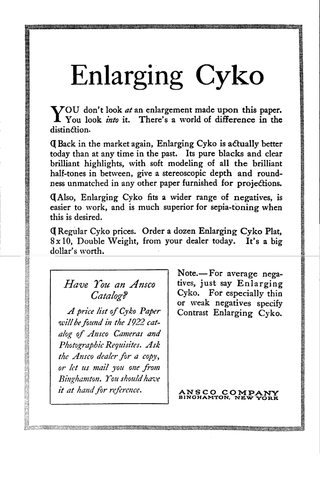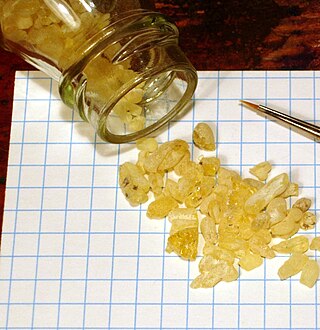
Amber is fossilized tree resin that has been appreciated for its color and natural beauty since Neolithic times. Much valued from antiquity to the present as a gemstone, amber is made into a variety of decorative objects. Amber is used in jewelry and has been used as a healing agent in folk medicine.

Bakelite, formally Polyoxybenzylmethyleneglycolanhydride, is a thermosetting phenol formaldehyde resin, formed from a condensation reaction of phenol with formaldehyde. The first plastic made from synthetic components, it was developed by the Belgian chemist and inventor Leo Baekeland in Yonkers, New York in 1907, and patented on December 7, 1909.

Photographic paper is a paper coated with a light-sensitive chemical formula, like photographic film, used for making photographic prints. When photographic paper is exposed to light, it captures a latent image that is then developed to form a visible image; with most papers the image density from exposure can be sufficient to not require further development, aside from fixing and clearing, though latent exposure is also usually present. The light-sensitive layer of the paper is called the emulsion. The most common chemistry was based on silver halide but other alternatives have also been used.

Epoxy is the family of basic components or cured end products of epoxy resins. Epoxy resins, also known as polyepoxides, are a class of reactive prepolymers and polymers which contain epoxide groups. The epoxide functional group is also collectively called epoxy. The IUPAC name for an epoxide group is an oxirane.

Varnish is a clear transparent hard protective coating or film. It is not to be confused with wood stain. It usually has a yellowish shade due to the manufacturing process and materials used, but it may also be pigmented as desired. It is sold commercially in various shades.

Lacquer is a type of hard and usually shiny coating or finish applied to materials such as wood or metal. It is most often made from resin extracted from trees and waxes and has been in use since antiquity.

Frankincense is an aromatic resin used in incense and perfumes, obtained from trees of the genus Boswellia in the family Burseraceae. The word is from Old French franc encens. There are several species of Boswellia that produce true frankincense: Boswellia sacra, B. frereana, B. serrata, and B. papyrifera. Resin from each is available in various grades, which depends on the time of harvesting. The resin is hand-sorted for quality.

An ion-exchange resin or ion-exchange polymer is a resin or polymer that acts as a medium for ion exchange. It is an insoluble matrix normally in the form of small microbeads, usually white or yellowish, fabricated from an organic polymer substrate. The beads are typically porous, providing a large surface area on and inside them where the trapping of ions occurs along with the accompanying release of other ions, and thus the process is called ion exchange. There are multiple types of ion-exchange resin. Most commercial resins are made of polystyrene sulfonate, followed up by polyacrylate.

Phillips Petroleum Company was an American oil company incorporated in 1917 that expanded into petroleum refining, marketing and transportation, natural gas gathering and the chemicals sectors. It was Phillips Petroleum that first found oil in the North Sea on December 23, 1969, at a position that was later named Ekofisk.
NOVA Chemicals Corporation is a Canadian petrochemical company that has been in operation since 1954. NOVA was formed as provincial crown corporation called the Alberta Gas Trunk Line Company Limited to manage Alberta's natural gas collection system. During the 1970s, the company diversified into petroleum exploration and production, manufacturing, and petrochemicals. In 1980 the AGTL was renamed NOVA, An Alberta Corporation. After a decade of financial struggles, in 1998 NOVA sold its petroleum and pipeline business to TransCanada Pipelines and continued as solely a petrochemicals operation. The gas collection system run by TransCanada is now called the NOVA Gas Transmission Line.

Styrax is a genus of about 130 species of large shrubs or small trees in the family Styracaceae, mostly native to warm temperate to tropical regions of the Northern Hemisphere, with the majority in eastern and southeastern Asia, but also crossing the equator in South America. The resin obtained from the tree is called benzoin or storax.

Low-density polyethylene (LDPE) is a thermoplastic made from the monomer ethylene. It was the first grade of polyethylene, produced in 1933 by Dr John C. Swallow and M.W Perrin who were working for Imperial Chemical Industries (ICI) using a high pressure process via free radical polymerization. Its manufacture employs the same method today. The EPA estimates 5.7% of LDPE is recycled in the United States. Despite competition from more modern polymers, LDPE continues to be an important plastic grade. In 2013 the worldwide LDPE market reached a volume of about US$33 billion.

Sandarac is a resin obtained from the small cypress-like tree Tetraclinis articulata. The tree is native to the northwest of Africa with a notable presence in the Southern Morocco part of the Atlas mountains. The resin exudes naturally on the stems of the tree. It is also obtained by making cuts on the bark. It solidifies when exposed to the air. It comes to commerce in the form of small solid chips, translucent, and having a delicate yellow tinge. Morocco has been the main place of origin of sandarac. A similar resin is obtained in southern Australia from some species of the Australian cypress-like trees Callitris, but the resin has not been systematically collected in Australia.
Micarta is a brand name for composites of linen, canvas, paper, fiberglass, carbon fiber, or other fabric in a thermosetting plastic. It was originally used in electrical and decorative applications. Micarta was developed by George Westinghouse at least as early as 1910 using phenolic resins invented by Leo Baekeland. These resins were used to impregnate paper and cotton fabric which were cured under pressure and high temperature to produce laminates. In later years this manufacturing method included the use of fiberglass fabric, and other resin types were also used. Today Micarta high-pressure industrial laminates are produced with a wide variety of resins and fibers. The term has been used generically for most resin impregnated fiber compounds. Common uses of modern high-pressure laminates include electrical insulators, printed circuit board substrates, and knife handles.
Ineos Group Limited is a British multinational chemicals company headquartered and registered in London. As of 2021, it is the fourth largest chemical company in the world. Ineos is organised into about 20 standalone business units, each with its own board and operating almost entirely independently, although founder Sir Jim Ratcliffe and his associates sit on their boards occasionally.
Zytel is a trademark owned by Celanese and used for a number of different high strength, abrasion and impact resistant thermoplastic polyamide formulations of the family more commonly known as nylon. The Zytel product line is based mostly on nylon 66, but also includes grades based on nylon 6 as a matrix, long chain nylons such as nylon 610, and copolymers including a transparent resin called Zytel 330. Resins based on polyphthalamides are branded 'Zytel HTN'. The Zytel product range takes advantage of the fact that nylons are one of the most compatible polymers with modifiers and so offers grades with varying degrees of fiberglass, from 13% to 60%,, rubber toughened resins, flame retarded grades. Nylon resins with mineral reinforcement are branded 'Minlon'.
Wood glue is an adhesive used to tightly bond pieces of wood together. Many substances have been used as glues.

Sir James Arthur Ratcliffe is a British billionaire, chemical engineer and businessman. Ratcliffe is the chairman and chief executive officer (CEO) of the INEOS chemicals group, which he founded in 1998. The company is estimated to have had a turnover of $65 billion in 2021. He does not have a high public profile, and was once described by The Sunday Times as "publicity shy". In May 2018, Ratcliffe was the richest person in the UK, with a net worth of £21.05 billion. As of May 2023, the Sunday Times Rich List 2023 estimated his net worth at £29.688 billion, making him the second wealthiest figure in the UK. In September 2020, Ratcliffe officially changed his tax residence from Hampshire to Monaco, a move that it is estimated will save him £4 billion in tax.
Polymer engineering is generally an engineering field that designs, analyses, and modifies polymer materials. Polymer engineering covers aspects of the petrochemical industry, polymerization, structure and characterization of polymers, properties of polymers, compounding and processing of polymers and description of major polymers, structure property relations and applications.
INEOS Styrolution is a global styrenics supplier and is headquartered in Germany. It is a subcompany of INEOS and provides styrenics applications for many everyday products across a broad range of industries, including automotive, electronics, household, construction, healthcare, packaging and toys/sports/leisure.












